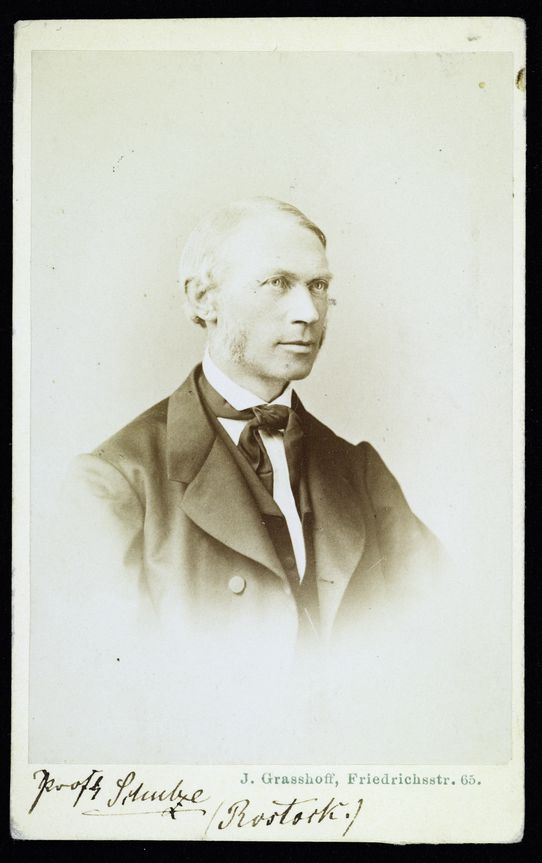Franz Schulze on:
[Wikipedia]
[Google]
[Amazon]
 Franz Ferdinand Schulze (17 January 1815 – 14 April 1873) was a German professor of chemistry and microbiology who taught at the Royal Prussian State Agricultural Academy in Eldena and later at Rostock. He innovated analytical techniques, particularly making use of specially blown glass tubes. He examined questions such as spontaneous generation in his experiments. He was able to demonstrate that when air was bubbled through sulfuric acid, the resulting air did not produce any growth in carefully sterilized culture media. He translated J. F. W. Johnston's ''Elements of Agricultural Chemistry and Geology'' (1841) into German. He coined the name of the wood component
Franz Ferdinand Schulze (17 January 1815 – 14 April 1873) was a German professor of chemistry and microbiology who taught at the Royal Prussian State Agricultural Academy in Eldena and later at Rostock. He innovated analytical techniques, particularly making use of specially blown glass tubes. He examined questions such as spontaneous generation in his experiments. He was able to demonstrate that when air was bubbled through sulfuric acid, the resulting air did not produce any growth in carefully sterilized culture media. He translated J. F. W. Johnston's ''Elements of Agricultural Chemistry and Geology'' (1841) into German. He coined the name of the wood component
 Schulze was born in
Schulze was born in
 Franz Ferdinand Schulze (17 January 1815 – 14 April 1873) was a German professor of chemistry and microbiology who taught at the Royal Prussian State Agricultural Academy in Eldena and later at Rostock. He innovated analytical techniques, particularly making use of specially blown glass tubes. He examined questions such as spontaneous generation in his experiments. He was able to demonstrate that when air was bubbled through sulfuric acid, the resulting air did not produce any growth in carefully sterilized culture media. He translated J. F. W. Johnston's ''Elements of Agricultural Chemistry and Geology'' (1841) into German. He coined the name of the wood component
Franz Ferdinand Schulze (17 January 1815 – 14 April 1873) was a German professor of chemistry and microbiology who taught at the Royal Prussian State Agricultural Academy in Eldena and later at Rostock. He innovated analytical techniques, particularly making use of specially blown glass tubes. He examined questions such as spontaneous generation in his experiments. He was able to demonstrate that when air was bubbled through sulfuric acid, the resulting air did not produce any growth in carefully sterilized culture media. He translated J. F. W. Johnston's ''Elements of Agricultural Chemistry and Geology'' (1841) into German. He coined the name of the wood component lignin
Lignin is a class of complex organic polymers that form key structural materials in the support tissues of most plants. Lignins are particularly important in the formation of cell walls, especially in wood and bark, because they lend rigidity ...
in 1857.
Life and work
 Schulze was born in
Schulze was born in Naumburg
Naumburg () is a town in (and the administrative capital of) the district Burgenlandkreis, in the state of Saxony-Anhalt, Central Germany (cultural area), Central Germany. It has a population of around 33,000. The Naumburg Cathedral became a UNES ...
, second son of a craftsman. An uncle took care of him from the age of ten, and he grew up in Meissen
Meissen (in German orthography: ''Meißen'', ) is a town of approximately 30,000 about northwest of Dresden on both banks of the Elbe river in the Free State of Saxony, in eastern Germany. Meissen is the home of Meissen porcelain, the Albrecht ...
where he went to school. He returned to Naumburg where he passed his abitur
''Abitur'' (), often shortened colloquially to ''Abi'', is a qualification granted at the end of secondary education in Germany. It is conferred on students who pass their final exams at the end of ISCED 3, usually after twelve or thirteen year ...
in 1832 and then went to study in Leipzig. Here he took an interest in the natural sciences and listened to lectures in zoology at Berlin by Hinrich Lichtenstein. He received a doctorate with a dissertation on "''De planariarum vivendi ratione et structura penitiore''" following which he worked in Eilhard Mitscherlich's laboratory. He became a teacher of chemistry at the newly founded Agricultural Academy in Eldena in 1835 and habilitated in 1837 at the University of Greifswald. He wrote a textbook on agricultural chemistry and in 1850 he moved to Rostock as a full professor. He continued some of the agricultural chemistry investigations he had begun at Eldena and became more involved in the study of hygiene. After cholera struck Rostock in 1866, he conducted studies on airborne micro-organisms, noting their possible role in putrefaction. As early as 1836, he built glassware to bubble air through sulfuric acid to demonstrate that such treated air did not lead to growth on sterile and isolated media. This method was developed on by Theodor Schwann, John Tyndall
John Tyndall FRS (; 2 August 1820 – 4 December 1893) was a prominent 19th-century Irish physicist. His scientific fame arose in the 1850s from his study of diamagnetism. Later he made discoveries in the realms of infrared radiation and the p ...
and others in the early debates on spontaneous generation.
Schulze married Charlotte, daughter of Sydow zu Charlottenburg, in Eldena in 1839 and they had two sons, the older Franz Eilhard Schulze (the middle name from his godfather Mitscherlich) became a zoologist. After the death of Charlotte in 1850 he married Mathilde von Langermann in 1852. He died from pneumonia at Rostock.
References
{{DEFAULTSORT:Schulze, Franz Ferdinand 1815 births 1873 deaths German chemists Chemists from the Kingdom of Prussia